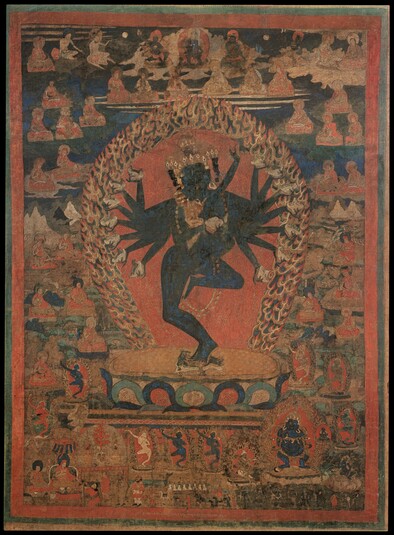
Item: Hevajra (Buddhist Deity)
| Origin Location | Central Tibet |
|---|---|
| Date Range | 1500 - 1599 |
| Lineages | Sakya and Ngor (Sakya) |
| Material | Ground Mineral Pigment on Cotton |
| Collection | Navin Kumar |
Classification: Deity
Shri Hevajra (Tibetan: pal gye pa dor je) the central meditational deity of the Sakya School along with teachers of the lineage above and at the sides and fierce protectors below.
Sanskrit: Hevajra Tibetan: Gye pa dor je
Tibetan: Gye pa dor je
Semi-wrathful in appearance, dark blue in colour with eight faces, sixteen hands and four legs he stands in a dancing posture. The central face is blue, right white, left red, upper face smoky coloured and the four remaining side faces black. The first pair of hands crossed at the heart hold skullcups and embrace the consort Vajra Nairatmya, blue, with one face and two hands. The remaining hands are extended out to the sides each holding a skullcup. Each face has three eyes and yellow hair flowing upward like flames. Adorned with crowns of five skulls, bone ornaments and a garland of fifty fresh heads they both stand atop four stacked figures, a sun disc, multi-coloured lotus blossom and a throne seat surrounded by the orange and red flames of pristine awareness fire. Encircling the throne are the eight goddesses of various colours making up the Hevajra Nine-deity Mandala. They each have one face and two hands holding in the right a curved knife aloft and a skullcup to the heart with the left, standing in a dancing posture with the right leg raised up.
At the top center is the primordial buddha Vajradhara, at the left is a seated Nairatmya and at the right the Indian mahasiddha Virupa. The remaining figures gathered at the top and sides are mahasiddhas, monks and laypersons of the Hevajra lineage of India and Tibet.
At the lower right is the wrathful protector Panjarnata Mahakala, blue-black in colour, with one face and two hands holding a curved knife and skullcup to the heart, in a standing posture encircled by flames surrounded by the 7 attendants. Slightly to the left is Brahmarupa Mahakala in the appearance of an Indian mahasiddha, brown of colour, holding a shinbone horn. At the right is Shri Devi, blue, with one face and four hands, riding a mule.
At the bottom left, surrounded by attendants, is a lama wearing the robes of a monk and red pandita hat. In front a long table supports a line of torma offerings (stylized food), white and cone shaped. Various other types of offerings are neatly arranged.
Hevajra Lineage: Vajradhara, Nairatmya, Virupa, Kanhapa, Damarupa, Avadhutipa, Gayadhara, Drogmi Lotsawa, Seton Kunrig, Shangton Chobar, Sachen Kunga Nyingpo (1092-1158), Sonam Tsemo (1142-1182), Trakpa Gyaltsen (1147-1216), Sakya Pandita (1182-1251), Chogyal Pagpa (1235-1280), etc.
Jeff Watt 3-99
Front of Painting
Wylie Transliteration of Inscription: rgyal tshab dam pa'i yid dam kye rdor 'di, dbang sung padma bdag gis su ga rjes lags, mangalam.
Publication: Tibetan Paintings
Thematic Sets
Tradition: Sakya Deity Paintings
Buddhist Deity: Hevajra Main Page
Collection of Navin Kumar Gallery: Painting
Buddhist Deity: Hevajra, Deity Paintings
